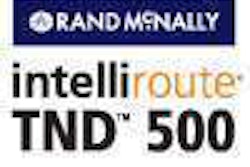California has long had the reputation as a renegade on environmental matters. For years, this generally wasn’t an enormous problem for trucking.
Several years ago, fleet owners got a taste of what was to come when the state imposed a five-minute idling ban, followed last year by an end of the exemption on overnight idling and the regulation of diesel-fueled auxiliary power units on new trucks.
Those are minor intrusions into your fleet management, however, compared to what lies ahead: Rules dictating key specs for your tractor’s styling, engine emissions, particulate filters, reefer units, aerodynamic devices and even the tires you run. Several regulations require detailed recordkeeping and reporting and offer multiple compliance options. And they all apply to trucks operating in California regardless of where they are based.
Of course, you always have the option of avoiding California – the nation’s most populous state and home to some of the nation’s busiest ports. But even if you don’t run in California now, the state’s demands regarding spec’ing can affect the residual value of equipment operated elsewhere.
And what happens in California, doesn’t necessarily stay in California.
“California is a trendsetter,” notes Glen Kedzie, vice president and environmental counsel for the American Trucking Associations. “It moves faster than the Environmental Protection Agency. It moves faster than Congress. Everyone is playing catch-up.” Indeed, it’s not unusual to see states and federal agencies seek to conform their own regulations to CARB because that’s the easiest way to go, Kedzie says.
Clearing the air
Most CARB regulations affecting heavy-duty trucks are aimed at reducing pollutants, such as nitrogen oxide (NOx) and particulate matter (PM), in the nation’s largest “nonattainment area” – regions where the air quality doesn’t meet national standards.
The most comprehensive of the air quality rules is the truck and bus rule, which will require, with limited exceptions, that trucks with 14,000 pounds gross vehicle weight ratings (GVWRs) have PM filters by 2014 and meet model year 2010 engines by 2023. Under this rule, which was adopted last year but has yet to be published formally, any truck engine less than seven years old is always in compliance. CARB, therefore, assumes that the rule will affect mostly in-state fleets since longer-haul operations would be operating newer equipment. That might be true in the aggregate, but many individual truck operators could be in for a surprise.
A separate program aimed at drayage operations kicks in at the end of the year for Class 8 trucks that service ports and intermodal rail yards. For those operations, all trucks would have to meet 2007 emissions standards by 2014, and – like the truck and bus rule – 2010 engine standards are required for all trucks by 2023. CARB’s intent is for fleets to be subject to either truck and bus or drayage – but not both – depending on their situation.
A controversial regulation to curtail NOx and PM affects transport refrigerated units (TRUs) on trailers. The rule was adopted a couple of years ago, but it was held up until CARB obtained an EPA waiver in the waning days of the Bush administration. That regulation, which ATA is challenging in federal appeals court, bans reefer-unit diesel engines older than model year 2001 and establishes a replacement/retrofit schedule, with phaseout/retrofit requirements beginning next year. In a sign of what could happen in the future with other rules, many fleets saw the residual value of refrigerated trailers with older reefer units plummet in anticipation of the rule.
Dictating design
People who live in or have visited California can appreciate the need to improve air quality. California’s efforts on climate change are more controversial, however, since the concern is global, not local. California is ahead of other states in regulating greenhouse gases (GHGs), but others will follow, perhaps as part of regional initiatives in the Midwest, West and New England that already have formed. And earlier this year, EPA issued a tentative finding that greenhouse gases were toxins and, therefore, subject to regulation under the Clean Air Act.
In a sense, CARB’s regulation addressing GHGs from heavy-duty vehicles, which is expected to be finalized by November, is one of the few areas where the state agency is following EPA’s lead. The regulation’s focus is reducing GHGs by making equipment more fuel-efficient. So CARB is pegging its mandatory equipment choices to tractors, trailers and devices verified by EPA’s SmartWay-voluntary program. CARB adopted the rule in December in draft form and issued a proposed final version for comment in September. The agency plans to finalize the rule by November.
Principally because aerodynamics lie at the heart of CARB’s heavy-duty GHG reduction rule, it only applies to carriers operating long-haul within California using 53-foot box-type trailers. In general, new model year 2011 or later sleeper-equipped trucks would have to be certified by SmartWay and would have to use tires verified by SmartWay as being low rolling-resistance. Day cabs would need only the tires. Each of the major heavy-duty truck manufacturers offers at least one high-roof sleeper cab tractor that is certified by SmartWay.
Trucks built before Jan. 1 would not be barred from operating in California, although eventually they likely would have to be replaced or retrofit anyway in order to comply with the truck and bus rule. Low rolling-resistance tires would have to be retrofit by Jan. 1, 2012, however. In effect, therefore, tires and casings already in use or being purchased today could be rendered obsolete in just over two years – at least on trucks affected by the CARB rule. Currently, Bridgestone, Continental, Goodyear, Hankook, Michelin and Yokohama offer steer, drive and trailer tires that meet SmartWay requirements.
For model year 2011 trailers built after Jan. 1, compliance means low rolling-resistance tires and either SmartWay certification of the whole trailer or a combination of aerodynamic technologies meeting certain fuel economy improvement minimums. In general, aerodynamic and tire retrofits would be required by 2013, although CARB offers separate optional compliance schedules for large and small fleets – the dividing line being 21 trailers – that would allow for later retrofit of some portion of the trailer population.
A complete list of equipment that is certified or verified by CARB is available at www.epa.gov/smartway under the title “SmartWay Tractor & Trailer License Agreement”
CARB’s draft SmartWay regulation circulated for comment in September included several significant changes and clarifications from the version adopted in December. For example, CARB clarified that a trucking company could be held accountable if it dispatches to California an owner-operator that isn’t compliant. Also, CARB staff has clarified that retreads are acceptable as long as the casing is identifiable as a model of tire on the SmartWay list of verified technologies. Another planned change would redefine a “fleet” as all equipment held under common ownership or control even if operated in different subsidiaries or divisions. California is taking greater control over fleet operations. Either learn the ins and outs – or stay out.








